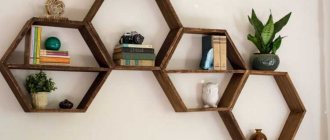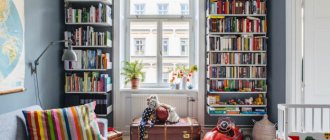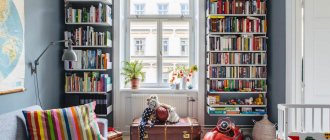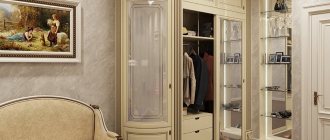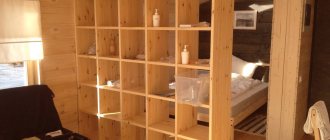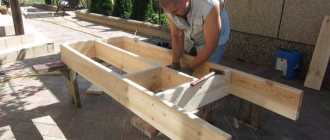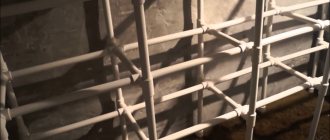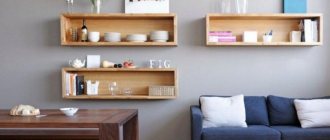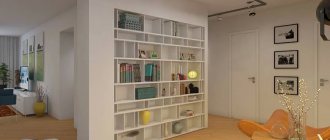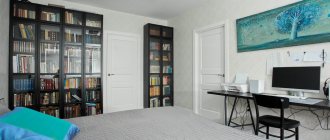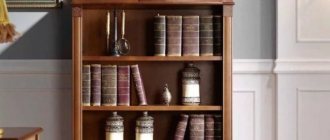Design options
The time of standard places for storing books and small trinkets is long gone, and now designers are presenting dozens of options for using shelves in the living room interior. Several groups can be distinguished:
- Standard shelves of various sizes and configurations;
- Shelves-partitions;
- High open options or “slides”;
- Figured modules;
- “Floating” or built-in models;
- Shelves built under furniture: armchairs, sofas;
- Corner structures;
- Arched compositions;
- Original handmade products.
Classic wall shelves for the living room are a familiar product made of fastened boards or panels in the form of a lattice.
To zone the interior space in studio apartments, partition shelves made in the form of racks the full height of the wall are used.
“Slides” differ from fences by the presence of uneven edges or steps, which make the design unusual.
Multi-colored modules suggest a kind of construction game, when whole compositions are assembled from squares, rectangles or triangles. Their main advantages: mobility, non-standard nature and quick assembly and disassembly.
Built-in and corner shelves are made to order and use “dead” room areas: wall joints, narrow niches and openings.
An interesting solution could be furniture, the armrests and base of which can be allocated as open sections for placing various items.
Arched compositions are often included in original products, as they are made in the form of a U-shaped shelf above a sofa, armchair or TV. Like other handmade models, they are unconventional, unusual and unique.
Restoring an Old Shelf Using Homemade Chalk Paint
Almost every home has an old shelf that has been an eyesore for a long time, but it was a pity to throw it away. What can be done with it so that it fits harmoniously into the interior? Let's try to decorate it using homemade chalk paint.
First of all, we need to decide on the functionality of our shelf: where it will be located - in the kitchen, room, hallway, or in the country house. This will determine what materials can be used. For example, country wooden furniture must be treated against fungus and mold and must have a moisture-resistant coating; if the shelf hangs in the kitchen, then it should be ready for intensive cleaning using detergents and so on. I decided that my shelf would be more useful in my fifth-grader’s room so that he could put away his school textbooks and sheet music without fear of being “read” by his little sister.
So, the image begins to gradually take shape - we will make a shelf for books in the room of a teenage boy. Now you need to decide how the shelf will look, that is, create a design project. To be honest, I can’t work if I don’t imagine the future product. A certain image, a photograph, should form in your head. Although I know that many masters work on inspiration, and they produce excellent work. But I still live by the principle, which is expressed in one quote: “If we do not know where we are going, we will be very surprised if we arrive in the wrong place.” After consulting with my son, we chose the “Journey” look and the “Old Attic” style. It is not intrusive, it suits his character well and does not depend on teenage fashion. I select the color scheme, focusing on harmonious color palettes. The following palette suited the interior of the room:
Now I need my favorite thing when working with wood, plywood, especially prefabricated products - a sanding machine. Use 80 or 100 grit sandpaper to smooth out the putty. Then, using sandpaper No. 150-200, we go over the entire shelf from the outside and inside. In summer I sand on the balcony, and in cold weather in the bathroom.
Now is the time to start making your chalk paint. On the Internet I found several recipes for chalk paint, with grout, plaster, tooth powder, calcium carbonate, soda, starch, etc. And what I want to say is that the quality of the paint will depend on the ingredients that you have available. Basically, a chalk paint recipe includes 3-4 main components: 1) water-dispersion paint (latex or acrylic); 2) gypsum, grout, starch, soda, and so on; 3) water. The quality of chalk paint will depend on the composition of each component. When I first became interested in chalk paint, I took the most common recipe, which is in Svetlana Shamshina’s book, but the paint turned out to be of disgusting quality. I believe this is because we do not have latex paint from the companies that craftsmen use to make chalk paint. If I add grout in the proportions specified in the recipe, then the latex paint curls up into a lump, and if it is less, then when varnishing, the paint is washed off with varnish. Then I decided to look into this issue, what was wrong. It turns out that the composition of latex paint for walls and ceilings is very diverse, from acrylic to carbonate base. Accordingly, the result of applying paint will be different. The same goes for the second component, especially if you use plaster. The fact is that gypsum comes in different consistencies. I tried to use architectural plaster and plaster for children's crafts - the paint did not work out, since the gypsum was ground too coarsely, in addition, the quality of the gypsum itself may be low. On English-language sites, the so-called “Gypsum of Paris” is mainly used to prepare chalk paint, which many consider to be the standard of quality.
What else would I like to say about preparing chalk paint? Never take a recipe thoughtlessly; try to understand the ingredients. This will give you more room to experiment. Think about what role each component plays in the composition. For example, carbonate latex paints are more fragile; using chalk paint based on them can very successfully emphasize the structure of the wood in a product. To do this, apply the paint, let it dry, and then sand it with a soft sanding sponge. If you need a durable base, then try latex paint for exterior and interior use. I also tried making acrylic-based chalk paint for exterior and interior use, and the result was also good. As for the second component - grout for joints or dry gypsum putty, the consistency of the paint, the strength of the coating, and resistance to external influences depend on them - the more of the second component, the thicker and harder the coating will be.
Another point is why I don't like using just acrylic paint to paint furniture. I read a lot of master classes at the Crafts Fair and many people use simple construction acrylic paint. But I don't like that it doesn't give an even coverage, leaves brush marks and comes off quickly. Chalk paint is multi-component and can have as many functions and effects as you want. You need to try, don’t be afraid to experiment. As a result of numerous experiments, I have developed my own recipe for chalk paint, which is not inferior in quality to industrial paint, but for now I will not publish it until I test it with various decorating techniques.
How to make shelf decor
The shelf can be decorated with lighting.
The second inexpensive way to decorate a shelf (for example, with books) is to install special shelf inserts. They usually look like a miniature piece of some street and look very good among the books from which the depicted place was taken. The third way (very expensive now) is to buy several books of the same series - the same spines look very interesting on the shelf and give the whole composition a certain “image integrity”.
In the living room
What kind of shelf do you need for your living room? To understand this, you first need to decide what to put on the shelf in the living room? If there are quite a few things that could be placed there, then a huge rack is not needed at all, a small shelf will be enough. For books and other important things that you would like to put on display, it is better to choose several open beautiful shelves or a small shelving unit that matches the decor of the living room.
The shelf in the living room is often decorated with photo frames.
If there are a lot of things, you should give preference to a large shelving unit, which will have enough space for books, films, a TV, and even a couple of cute figurines that will be great to decorate the room.
In the hall
A shelf in the hallway is, first of all, a functional thing. Typically, a wall or hanging shelf in the hallway is used to store small items that need to be used or taken with you before leaving the house - antiseptic, sunglasses, gloves, mask and more. Usually, along with such a shelf, a mirror is attached to the wall.
In the hallway you can make an interesting corner shelf.
Floor shelves in the hallway usually play the role of a shoe rack - these are deep drawers (usually closed) in which all shoes suitable for a particular season are stored in open access. The floor shelf should accommodate three pairs of sneakers and sneakers, as well as winter boots - in a word, all the necessary shoes so that you can safely go outside.
In the kitchen
A shelf in the kitchen should also be functional first and foremost. Usually, dishes, various culinary utensils and products are stored on kitchen shelves - cereals, spices, everything that can be stored at room temperature (not in the refrigerator or freezer).
Shelves in the kitchen are needed to store dishes.
Therefore, kitchen shelves should be spacious (perhaps even more spacious than floor shelves in the hallway), securely fastened and conveniently placed so that apartment owners can quickly get everything they need and start cooking.
In the bathroom
Quite a lot of things are placed on a shelf in the bathroom, and therefore it must be deep enough, and its fastenings must be strong enough to withstand the weight of what will lie or stand there. Usually on the shelves in the bathroom there are a variety of cosmetics and various things that are used in the shower - pumice stones, nail files, washcloths and so on.
It is better to keep household chemicals behind closed doors, but books look great on open shelves.
For all these things, it is necessary to organize enough free space so that if something happens, one thing does not get caught on another when falling and does not drag the entire contents of the shelf along with it to the floor.
In the bedroom
Shelves in the corners can look like an ultra-modern design.
Near the bed itself, you can make another shelf on which a book, phone, glasses, hand cream and other useful things will lie. The shelf should not be too bulky, it is better to make the crossbars thinner, and choose plastic from the materials; this option will look good, but will not overload the interior of the room.
The choice of a shelf in the bedroom next to the bed must be approached with particular pedantry.
In the children's room
The shelf in the children's room should definitely be large - just enough for all the things that children need every day. Usually, a spacious shelving unit is installed in the nursery to provide more space on which all useful things can be placed, from toys and all sorts of materials for drawing/modeling/other things to notebooks and textbooks (for primary schoolchildren).
Such bright plastic shelves are perfect for a child's room.
A shelf or rack of this model will be a convenient addition and decoration for the room and a useful purchase that will definitely come in handy in everyday life.
Universal tips for creating a beautiful shelving
An open shelving unit is the “showcase” of your home. It should attract attention and decorate the interior.
Design: Shanade McAllister-Fisher Interior Design
No comments yet. Start the discussion!
Found a mistake? Select it and press Ctrl+Enter
The IVD.ru website is a leading Internet project dedicated to the issues of reconstruction and interior design of residential premises. The main content of the site is the archive of the magazine “Ideas for Your Home” - exclusive author’s articles, high-quality illustrations, practical tips and lessons. A team of professionals is working on the project in close collaboration with famous designers, architects and leading publishing experts.
On our website you can choose comprehensive design solutions; view detailed reviews of the market for construction and finishing materials, furniture, machinery and equipment; compare your own ideas with design projects of leading architects; communicate directly with other readers and editors on the forum.
Source
Functions of living room walls
The wall for the living room performs two main functions: practical and aesthetic.
A practical function is performed by closed cabinets, cupboards and chests of drawers, because it is customary to store various things used in everyday life in them. Such things can be clothes, folders with documents, and various devices such as a hair dryer, curling iron, etc.
Open cabinets and shelves serve an aesthetic function; they are filled with beautiful things that should complement the decor and decorate the living room.
Correct wall design
There are a lot of options for filling the wall, it all depends on the aesthetic tastes of the home owners and the availability of certain items.
But to prevent the wall from turning into a dump of souvenirs and dishes, you should take into account some features of its proper filling:
- if you decide to put books on the wall, place large thick volumes and tomes with damaged bindings on the top shelves, and place beautiful oversized books at eye level;
- cups, awards or certificates of one of the family members will be a wonderful decoration for the living room;
- to fill the wall with collections of souvenirs, you need to divide them according to their characteristic features and colors; arrange separately souvenirs that have a characteristic national flavor; the effectiveness of such a collection can be enhanced by embroidered napkins and other elements in the national style. Collections of romantic souvenirs can be supplemented with candles and flowers;
- If you have a lot of dishes and you want to arrange them on the wall, you shouldn’t display all the sets, put only the most beautiful ones in plain sight, and pack the simpler ones in beautiful baskets and bright boxes. Such boxes will also become an original decoration for the wall;
- To prevent your wall from looking motley and tasteless, try to use no more than three to four colors when filling it;
- Please note that small vases with flowers are in perfect harmony with any souvenirs, books and dishes.
In order for the wall of your living room to become the main decoration of this room, pay special attention to its content and let it become the most sophisticated element of decor.
Shelves are not only convenient and practical, but also aesthetically pleasing, because with the help of these simple structures and their contents you can completely transform your room space. Most often, hanging and corner shelves, racks and sections built into furniture are found in the living room, where they fit harmoniously and effectively into the overall design.
Playing out in the interior
Even an ordinary square shelf can become a full-fledged “highlight” in the interior; to do this, it is enough to play with it, showing imagination and ingenuity. Thus, the trend of this season is the uneven placement of simple square structures of various shades and configurations on the wall.
The distance between them can vary from 20 cm to opposite ends of the room. It is important that the number of such modules be more than three or four.
The following technique is also popular: painting the deep walls of nearby shelving compartments in bright contrasting colors. Mirrors inserted instead of backdrops also look luxurious.
Modern shelves are made in the most unusual configurations: specially curved, spiral-shaped, curly and disproportionate products.
Designers often use the technique of visually expanding space by purposefully leaving some sections empty. A free shelf illuminated by a built-in lamp or framed by an LED wire also looks interesting.
Original homemade shelves are always in fashion, while the artificial aging of the material, negligence, massiveness and sloppiness give them charm and originality.
You can decorate the product yourself, which will require leather or leatherette, metal elements, textiles, paper, stencil, tree branches or logs, paints, brushes, glue.
The first step is to think through the algorithm on paper, look at photographs of living room shelves designed by designers, look for ideas on the Internet, prepare the surface and get down to business.
When choosing any shelf, even the most modest in size, it is necessary to take into account certain points:
- For classic and minimalist styles, simple designs of regular shape and neutral shades are considered optimal;
- Instead of a standard shelf-stand for a TV, you can make a more original design: place two parallel boards under the panel at a distance of 20-30 cm, and place two more short ones on both sides;
- If a door or window opening occupies most of the wall, then you can make or order a U-shaped or L-shaped rack around it;
- You can separate one zone in a room from another using a high vertical or shaped shelf;
- It is better to choose alternating open and closed sections in order to have storage spaces hidden from prying eyes;
- Two parallel boards located next to each other, but only 20-30 cm “overlapping” each other, look beautiful on the wall;
- Universal colors - white, cream and woody light brown shades.
Rarely does a living room design go without a separate shelf or an entire shelving complex. Initially intended for storing small things necessary in life, they began to perform an aesthetic function.
The modern market offers hundreds of different configurations, body materials and color options, among which it is easy to choose the most suitable model for your existing interior. Or, inspired by ideas, make a shelf yourself.
Types of shelves
Today, the bulk of shelves and racks are divided according to several criteria:
Making a decision on each of the characteristics depends on the required functionality of the shelf or rack, the style and color scheme of the room. A shelf or rack should contain all the necessary things that you may always need.
It would also be a good option to have a shelf on which, in addition to useful things, you can place some decorations like photographs, figurines, various souvenirs and other things.
By appearance
By type - the first criterion from the list above - shelves are divided into three large categories:
Hanging shelves are usually located on brackets, pipes or special holders that are attached to a wall or other base. They are not very large, since the mounting on the brackets is not very reliable
Wall shelves are the most common type of such furniture. They, as the name suggests, are attached to the wall. This model is considered a fairly reliable option, since mounting to the wall provides sufficient strength.
A win-win option for decorating any room is shelves.
Floor shelves are more like cabinets or racks due to their rather large dimensions. Usually, in addition to being installed on the floor, they are also additionally secured to the wall with screws or other devices for greater stability.
By shape
Nowadays, construction and interior design stores offer an insane variety of forms of shelves and racks. Today on sale you can find both shelves of standard shapes (square, rectangular, flat (consisting of one crossbar)), and shelves of more rounded shapes (oval, round, ellipse).
Sometimes you need to be inspired by emptiness to make the interior more interesting.
A separate item are shelves and racks of unusual shapes such as rhombuses, “honeycombs”, triangles and others. The shape of the shelves should be chosen based on what exactly fits in a particular room and how many things need to be placed on them. The more things that need to take their place on the shelf, the more “convenient” shape and depth it should have.
Design
The design of the shelves is an important characteristic when choosing furniture for a room. They usually fall into two broad categories:
Open shelves - everything is simple here. They are called "open" because they do not have any doors or partitions at the front, ensuring that the contents of the shelves are always accessible to anyone who can reach them. Open shelves look quite nice and are very functional. But they have one significant drawback - a pet (for example, a cat) can climb into the open shelf and throw things onto the floor.
Almost always in the apartment there is an unoccupied free corner in which a rack or small shelf would be perfectly located.
You can, of course, choose a closed shelf - it has doors, thanks to which the things lying there will be protected not only from the intrusion of a pet, but also from prying eyes (for example, guests will not know that there are shelves behind the door unless they specifically try to climb into them ). True, such a model can burden the appearance of the room due to its similarity to a box.
On the corner shelf you can place various items.
By material
Typically, the following materials are used to make shelves:
Laminated sheets (chipboard and fibreboard) and plastic are the cheapest materials, and therefore are often used to create shelves in a low price category. They can be used in bedrooms, living rooms, halls or kitchens. Plastic shelves are often used for the bathroom.
Glass shelves are suitable for any bedroom style.
Wood and glass are more interesting materials that cost a little more than the previous ones. Wooden shelves are usually used in rooms where there are already pieces of furniture made of wood to create some kind of harmony, balance of colors and textures.
Mirror and glass shelves are made from hardened multilayer materials.
How to decorate open shelving shelves
Place books in boxes and baskets
One way to decorate a book shelf is to arrange them in low baskets and boxes. For example, sort them by author name or subject. This will make it easier to remove the book from the shelf, including in order to wipe off the dust.
Using this technique, experiment with the arrangement of volumes: covers up, or spines forward.
Design: LiLu Interiors
Tip: cardboard folders can be used to store two- and three-volume books; this will help in the visual organization of books and make the appearance of the shelving more impressive.
Leave some shelves empty
Sometimes you need to be inspired by emptiness to make the interior more interesting. This technique also works with open shelving decor. Leave some free space, this will add air and dynamics to the interior. In addition, empty shelves will help separate already arranged accessories from each other.
If you don't have a lot of storage space and leaving empty space seems like a luxury, combine open and closed shelves with doors and drawers. For example, for IKEA shelving, you can purchase removable doors and drawer inserts.
Place objects symmetrically to each other
One of the effective and simple ways to make a shelving unit stylish is to use the “mirror principle”, when the right side of the cabinet is symmetrical to the left. To do this, arrange items that are identical or as similar as possible to each other in color and shape on two single-level shelves. Paired vases, baskets, boxes or candles will help with this.
Design: Sabal Homes
Hide the spines of the books
The “not for everyone” option is to hide the spines of the books back against the wall of the shelf. It looks impressive and will certainly add zest to the room, and will also help create a monochrome interior.
Why is the option “not for everyone”? Firstly, this solution is not suitable for people with dust allergies. It is much easier to wipe the spines of books. Secondly, if you are an avid book reader, it will be inconvenient to choose the next book, taking one by one from the shelf to see the title.
Who might like it? Owners of large libraries who do not want to throw away ancient volumes, but also will definitely not read all the collections in the near future. We also recommend trying this technique for those who like experiments.
Create a design in several rows
One of the simple and working design techniques is to arrange objects in several rows. For example, on stacks of books there are small figurines or candles in candlesticks. This method makes small accessories more significant and noticeable.
6. Use the front of the rack to decorate
We're used to framed photographs and small paintings being placed on shelves, but we rarely see anyone hanging them on the front of a shelving unit. In this case, the shelves behind the painting or poster can be left empty or you can put not very aesthetic, but useful things. If you choose the second option, make sure that the objects covered by the picture can be easily reached.
Design: Paces Construction Co
Arrange books by color
Arranging books by spine color rather than alphabetically is a way to make your home library stand out. The technique is suitable not only for owners of a large number of books: you can simply fill one shelf with colored collected works, and the second with black and white.
Tip: you can not only put books, but also stack them on top of each other.
Design: Kropat Interior Design
How to place a shelf correctly
It’s worth thinking about how to properly place shelves on the wall in a room when choosing the shelves themselves. If this is a composition that forms an almost full-fledged rack, you need to place the shelves in accordance with the idea - one above the other, at a distance determined by the composition, or fasten one shelf to another so that all of them together look like a small cabinet attached to the wall.
Arranging books by spine color rather than alphabetically is a way to make your home library stand out.
Often, shelves are used to decorate walls in a special way, giving the room a more interesting and original appearance. In this case, the arrangement of the shelves should be a complete pattern that will catch the eye when entering the room.
DIY shelf decoration
Shelves and racks for a room are a great way to not only decorate any room, but also add a little (or a lot) of space for small items that you always need to have on hand. Today you can find just an insane number of shelf options to suit every taste, budget and interior.
Wall shelves of various types serve mainly to decorate the space of a house or apartment.
And many craftsmen even offer exclusive shelving that cannot be found anywhere else. Such an original item can easily change the appearance of a room, giving it brightness, beauty and freshness.
Types of materials for bookcases
There are the following types:
- Plastic.
- Metal.
- Wooden.
The plastic option will be the most cost-effective and practical. It's cheap and has a lot of color options. Such shelves do not grow moldy or get wet, and they weigh little. A nuance may be the fact that, in comparison with other options, it is less strong and durable. But again, depending on the purpose for which it is purchased.
Plastic shelf in the interior
Metal shelves are quite resistant to high humidity. The list of the most popular options includes chrome-plated metal structures, which are stable and last a long time.
The operation of a product made of such material is possible corrosion, which is inherent in any metal.
Metal shelf in the interior
Wooden shelves are a kind of classic that is always in demand. Wooden products will serve you for a long time, they just need proper care. From time to time it is worth treating the material against insects or cracks. Alternatively, you can varnish it, then it will be less troublesome.
Wooden shelf in the interior
